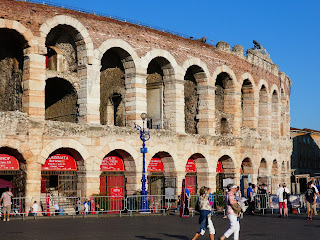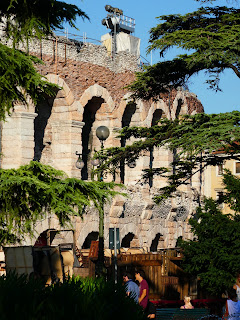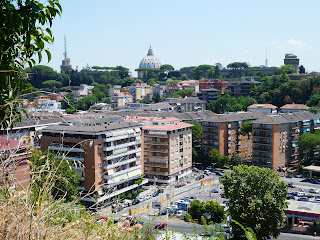In 2014, when walking through Verona I was fortunate enough to attend 3 operas in the Arena along with a concert by Placido Domingo, or rather half a concert as the second half was cancelled due to the weather. I decided then that if i were ever fortunate enough to be near Verona during the Arena opera season I would again go to the opera. As it transpired fortune has favoured me and I have been able to attend the opera, but not just one – four!
After catching the fast train from Rome to Verona I arrived at my B & B mid afternoon with plenty of time to go to the tourist office and collect my ticket for the first opera. I had planned to do a bit more sightseeing while in the city, but after spending nearly four months just taking one day at a time it felt strange planning sightseeing trips, and so I just pottered. I window shopped, strolled along the street eating gelato, crossed a bridge that I hadn’t seen last time I was there, and generally watched the world go by. I also spent time watching all the activity around the arena, which for me is absolutely fascinating.
Security has stepped up since the last time I was here. It is interesting how they have blocked streets, both in Verona, and in Rome. The strategic placement of very large planter boxes is a much more attractive option to barriers, and one doesn’t even realise that the street has been barricaded. Security has been stepped up for each performance at the arena too. They have it down to a fine art, but every one of the 7,000+ attendees has a bag inspection, and walks through an electronic security device.
The crowds were in Verona too
Attending four operas is exhausting and so each day I had to have a siesta, timed sot that I could watch a small portion of “le Tour”! Why is attending four operas exhausting you may be thinking. The answer to that is two fold. Firstly the mental energy required to sort out the plot lines, climb up and down the arena stairs and keep from fidgeting too much in the cramped position one is in sitting on the hot stone steps. Secondly it is the hour and length of the performance. I timed it so that I was able to see four different operas, two of which I had seen last time I was in Verona. Each performance begins at 9.00pm, though being Italy punctuality is not always adhered to! The finishing time varies, but the earliest time is around midnight, the latest being 1.00ish.
Which operas did I see? The first one was Carmen, then Turandot, Aida, and finally Nabucco. I had seen Carmen and Aida last time but both productions were new and so it was like seeing a new performance. Having said that the latest the opera finishes is around 1.00 is true if all runs according to plan, but when I saw Nabucco part way through the second act a few spots of rain fell. Half way through the aria everything stopped. The strings walked off, the harps were carried out by the stage hands, and the brass players sat on – their instruments regularly get a bath so a bit of water doesn’t hurt them, not like the strings and woodwind. After about 20 mins the performance resumed from the start of the aria that had been interrupted. Part way through the third act the same thing happened. This time it took a bit longer for the rain to clear, but finally it started again and eventually finished around 1.50am. Each night I had stopped, as many others did, and bought a gelato to eat on the way home, but even the gelati shops were closed on this night, though bars were still open for patrons to get an after opera drink or meal!
I was quite surprised by Nabucco. It is an opera that I didn’t know (other than the famous pilgrim’s chorus) and I found the music particularly melodious, as is the music of Aida – another Verdi opera. The set of this production was a bit disconcerting though – the “temple” looked to me like the grand house of Tara, from Gone with the Wind, and the costumes looked like 1800’s. I could have been mistaken for thinking it was about the American Civil War, or even the French Revolution! There was “gunfire” and cannons too – not in the original I am sure!
To give you an idea of the size of these productions in Nabucco there were at one point 10 horse on the stage along with about 150 people, and a horse and cart. In Carmen at one stage there were 3 1930’s style trucks, a jeep, and a motor bike and sidecar. Aida had on stage (not in the orchestra pit) 22 heraldic trumpeters performing in the grand march. I was so fascinated by the numbers of people involved that I did a head count and estimate that at times there were around 200 people on stage. Some of those were extras (perhaps stage hands dressed in costume etc), and included the wonderful 30 strong children’s choir used in Carmen, and the ballet of which there were about 30 performers. No microphones are used in either the orchestra pit of on the stage, yet everything can be heard clearly. To cap it off, each of these productions, complete with both lavish sets and costumes, is only performed once. The crew then bump out that production, bump in the next and are ready for the performance all within around 18 hours. And so it continues in this vein for around 2 months. An extraordinary feat. Sitting on the steps in the arena it costs the grand total of 25 Euro per performance, and though not the most comfortable, you miss nothing, and indeed from my point of view, you see more than on the floor of the arena for which you could pay as much as ten times more for a ticket!
The Arena
Sets for the operas are stored outside the arena and then either carried in or craned over the top
Turandot
Carmen
Aida. The people standing on the set give an indication of the size of the sets
Nabucco
The "warning bell" was this cymbal. She was always costumed, differently and appropriately for each performance.
Enough about the opera. After a very “short” night with the late finish and an early train to catch I headed to Munich. Here I was able to catch up with one new friend Mara, who I walked with for half a day about 6 weeks ago, and an old friend, Dominic, who lived with us fro a few months many years ago. I am now headed home after a wonderful 4 months adventure. The Via Romea Germanica is a very beautiful way, peopled with delightful characters only too willing to help and encourage. I have seen and experienced many things that I would not have seen if I were on a bus tour. Taking the time to see, smell and hear all that is happening around me, taking one day at a time, and taking each of those days one step at a time has meant that I have had the great good fortune to travel the 2,200 km path in a way that has allowed be many privileges.
Who knows when and where the next adventure will be. Until then, I am signing off. Thank you for your words of encouragement along the way. I have greatly appreciated them. Till next time, arrivederci.





















































